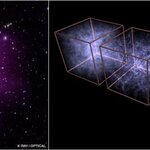Physics

Einstein and Bohr – No names loom larger in the history of twentieth-century physics, and rightly so, Albert Einstein and Niels Bohr being the figures most prominently associated with the relativity and quantum revolutions.(1)
Their names dominate, likewise, the history of philosophical reactions to the new physics of the twentieth century, Bohr for having identified complementarity as the chief novelty in the quantum description of nature,(2) Einstein for having found vindication in relativity theory for either positivism or realism, depending upon whom one asks.(3) Famous as is each in his…

Galaxy M87 is unique for three reasons. First, it is easily observable, It has twin jets, each some 5,000 light years long, and most importantly its core has little or no angular momentum. The latter point is very important, as if M87`s Core possessed angular momentum it would be a spiral galaxy.
JETTING AND ANGULAR MOMENTUM ARE THE UNIVERSAL PRIME MOVER
Universal, Galactic, Stellar and Solar Systems, stabilise as the progenitor jetting bodies lose their ability to Jet at…

Physicists at Indiana University have developed a promising new way to identify a possible abnormality in a fundamental building block of Einstein's theory of relativity known as "Lorentz invariance." If confirmed, the abnormality would disprove the basic tenet that the laws of physics remain the same for any two objects traveling at a constant speed or rotated relative to one another.
IU distinguished physics professor Alan Kostelecky and graduate student Jay Tasson take on the long-held notion of the exact symmetry promulgated in Einstein's 1905 theory and show in a paper to be published in…
The combination of a very pleasant but busy holiday visit with my In-laws and feeling a bit under the weather has caused my blogging to drop precipitously this past week. I'm back, ready to start off the New Year on the right foot with some free, meaty, internet science reading. (No, I'm not talking about my writing!)
Is there something missing at the heart of quantum mechanics? Einstein and Bohr, like King Kong vs. Godzilla, famously battled over the possible incompleteness of quantum mechanics.
According to the Heisenberg Uncertainty Principle, the more precisely we measure the momentum…

A friend was telling me the other day about a class he plans on taking on the philosophy of science. When I hear philosophy of science, I immediately think Richard Feynman. Feynman was, of course, not a philosopher, but a scientist par excellence. His lectures are filled with insights like these:
There is always the possibility of proving any definite [well-defined] theory wrong; but notice that we can never proce it right. Suppose that you invent a good guess, calculate the consequences, and discover every time that the consequences you have calculated agree with experiment. The theory is…

Nicolaus Copernicus's 1543 book, "On the Revolutions of the Heavenly Spheres", moved Earth from being the center of the Universe to just another planet orbiting the Sun. Since then, astronomers have extended the idea and formed the Copernican Principle, which says that our place in the Universe as a whole is completely ordinary, completely random and kind of a downer. Although the Copernican Principle is a pillar of modern cosmology, finding conclusive evidence that our neighborhood of the Universe really isn't special has proven difficult.
That's right, it's darn hard for Nihilists out there…
Quantum Space-Time Dynamics
Print: $33.60
Download: $10.00
General Relativity and Quantum Field Theory.
The glaring theoretical problem for 21st century physics is how tounite the two great theories of 20th century physics. I have done justthis by considering the problem from a fresh new perspective.The result is a theory that is mathematically simple and elegant. Basedon one postulate I am able to derive a very simple mathematicalformulation.
Using this formulation I find results for the Schwarzchildradius of a black hole, the bounce of a neutron in Earth's gravity, andthe entropy of a…

Found in the nearby Large Magellanic Cloud, 30 Doradus is one of the largest massive star forming regions close to the Milky Way. Enormous stars in 30 Doradus, also known as the Tarantula Nebula, are producing intense radiation and searing winds of multimillion-degree gas that carve out gigantic bubbles in the surrounding cooler gas and dust.
Other massive stars have raced through their evolution and exploded catastrophically as supernovae, expanding these bubbles into X-ray- brightened superbubbles. They leave behind pulsars as beacons of their former lives and expanding supernova…

Millions of 100-megaton hydrogen bombs exploding at once should be enough to tear anything apart, including atomic nuclei. But ever since observations of a solar flare from NASA's STEREO spacecraft in 2006 suggested otherwise, scientists have wondered how a large amount of hydrogen atoms managed to make through the flare seemingly unscathed.
NASA's twin Solar TErrestrial RElations Observatories, or STEREO, observed the massive December 5, 2006 solar flare event as it happened. The event was classified as an X9 on a scale where even an X1 is considered a large flare. Energy from the flare…

Researchers at MIT recently found an elegant solution to a sticky scientific problem in basic fluid mechanics: why water doesn't soak into soil at an even rate, but instead forms what look like fingers of fluid flowing downward.
Scientists call these rivulets "gravity fingers," and the explanation for their formation has to do with the surface tension where the water—or any liquid—meets the soil (or other medium). Knowing how to account for this phenomenon mathematically will have wide-ranging impact on science problems and engineering applications, including the recovery of oil from…